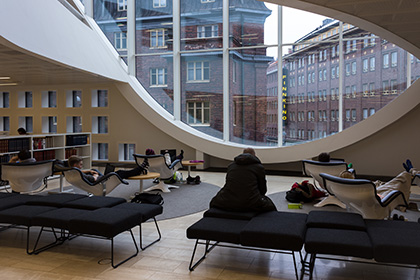The secret to Finnish education: Trust

Relaxed learning environment at Helsinki University Library
Finland has consistently been one of the most successful countries in global education rankings. For some, its name has become synonymous with educational excellence. While Finland is not alone in achieving world-class educational standards, what makes the country unique is that all of its schools are, effectively, elite schools: performance differences between Finnish schools account for just 5% of the total variation in student performance.
This means parents can rely on quality schooling wherever they enrol their children. The Finnish system is based on the assumption that all students can succeed, irrespective of their social background, and that all schools, no matter where they are located, should be of high quality.
Finland also shows that there are different paths to success. This is a system where students spend less time in school than in many of the highly competitive Asian systems. Finnish schools also tend to assign little homework and no longer have to undergo school inspections.
Finland has turned teaching into a sought-after career with high social status. It is difficult to get into teacher training courses, which are in high demand. In fact, only about one in ten applicants is accepted on average. Those who don’t succeed often turn to law or medical school instead, which indicates the prestige of the teaching profession. It is a job for people with master’s degrees, appealing to the brightest graduates. Once teachers are deployed to schools, they are expected to continuously upgrade their skills—professional development is compulsory. While not particularly highly paid (per-pupil budgets and teachers’ salaries are mid-range, by European standards), teaching is seen as an important and well-respected profession, and teachers are trusted and given great independence.
The significant investment Finnish leaders make in the professional development of their teachers is a critical part of the equation. Prospective teachers undergo rigorous preparation and, once certified, are given exceptional decision-making authority over things like curriculum and assessment. Finnish teachers command the same level of trust and autonomy that professionals in other fields do, such as medicine or law.
Some argue that this unusual trust-based culture makes it impossible to derive any real lessons from Finland. But, that trust is at least as much the fruit of policy decisions as it is a cultural pre-condition. The respect teachers have historically enjoyed in Finland creates a solid base on which to build reforms, as well as creating a virtuous circle of productive and innovative learning environments. The government’s trust, coupled with teachers’ status as university graduates from highly selective programmes, empower teachers to pursue their profession in ways that deepen the trust accorded them by parents and others in the community. In turn, the high level of policy coherence, meaning that decisions will be followed through across electoral cycles and political administrations, reinforces the trust Finnish teachers have in their education leaders.
Finland’s success in education did not happen overnight: it took many decades to achieve. It slowly and deliberately built itself into an education superpower through a series of reforms and in response to changing economic needs. In the late 1960s, shortly before Finland joined the OECD, there was a decision to move to a comprehensive system, making high-quality education available to all students, not just to the few selected for grammar schools. Implementation was not complete until the late 1970s. To make the transition successful, and to allay concerns about the changes, there was an accompanying drive to significantly improve the quality of teaching, notably by transferring teacher training to the universities and making it much more rigorous.
The economic context also served as impetus for change. In the early 1990s, Finland lurched into a deep recession. Unemployment figures reached nearly 20%, GDP was falling and public debt rising. Education offered a means of reshaping Finland’s economy, with a shift away from old industries such as pulp and rubber towards technology and the growing global market in telecommunications. The number of Finns working in research and development grew rapidly, in tandem with the rise of companies such as Nokia, which went from a 19th-century pulp-mill business to becoming one of the biggest names in mobile phones in the late 20th century and now a 21st-century leader in telecommunications systems.
And yet, at a time when the kinds of things that are easy to teach and test have also become easy to digitise and automate, the Finnish school system faces important challenges. Over the last decade, Finland has slipped on the OECD’s Programme for International Student Assessment (PISA) rankings, both in absolute terms but also because other education systems, notably in Asia, have rapidly improved. Moreover, as successful as Finnish schools are, youth unemployment is high, signalling that Finland needs to work harder to realign its education system with a rapidly changing world. Given Finland’s track record of change, there is good reason to hope that in the digital age, it can aim for top of the class again.
©OECD Observer January 2019
OECD (2018), Education at a Glance 2018: OECD Indicators, OECD Publishing, Paris, https://doi.org/10.1787/eag-2018-en. https://doi.org/
http://www.oecd.org/pisa/ http://www.oecd.org/pisa/
